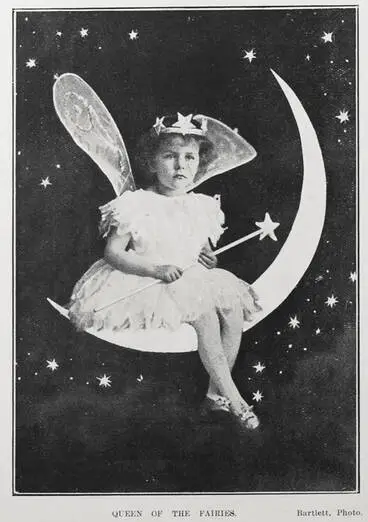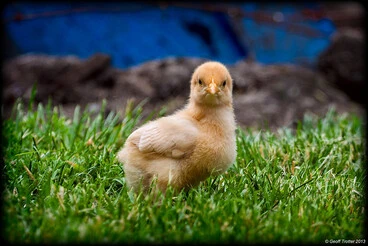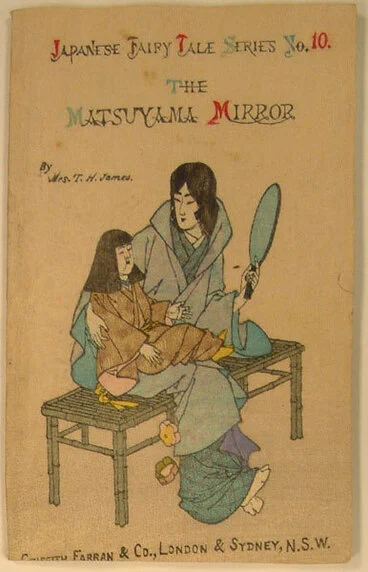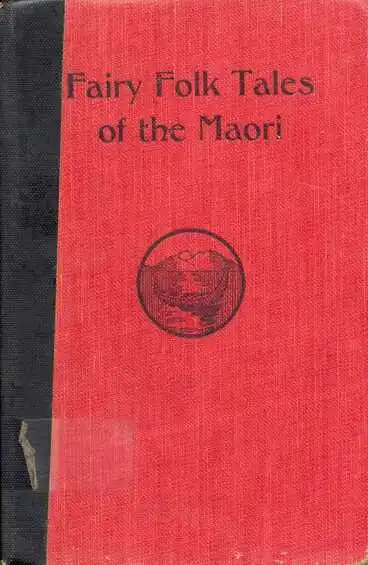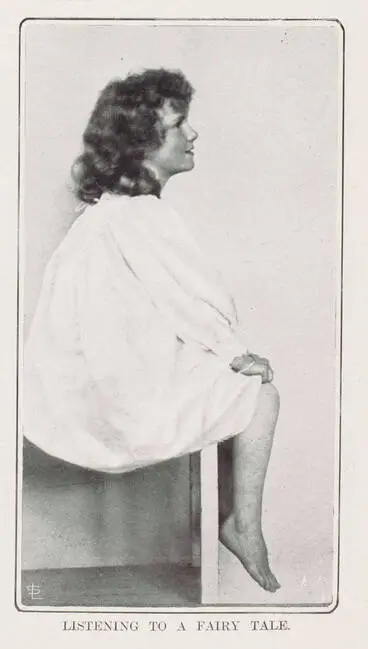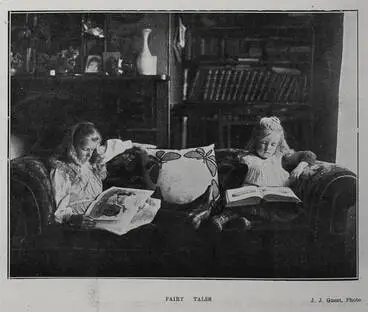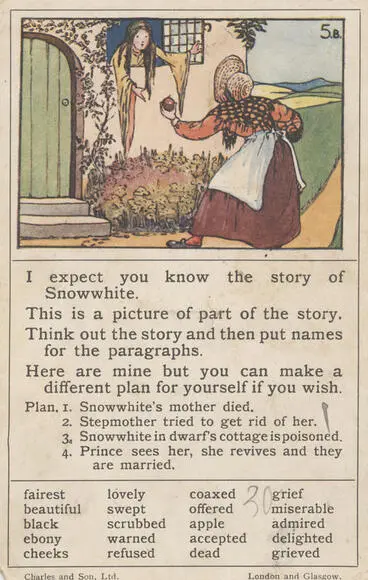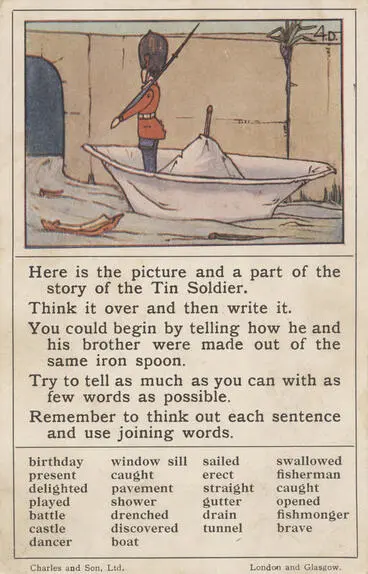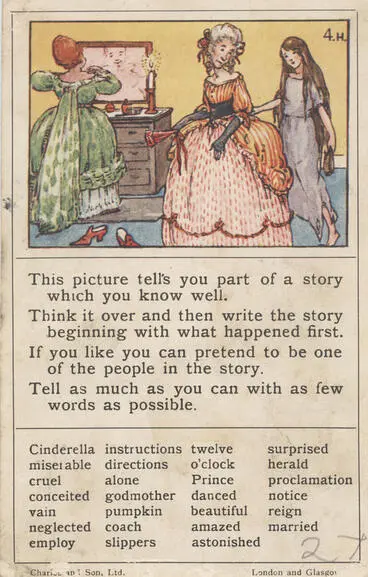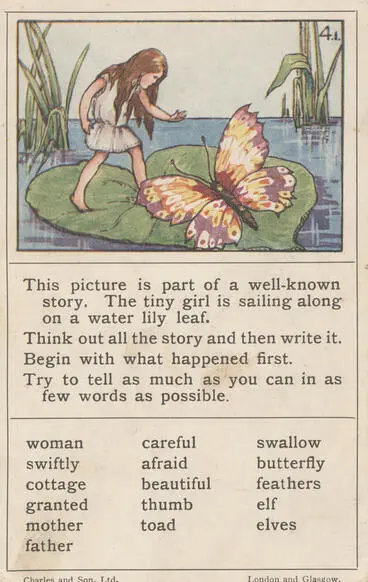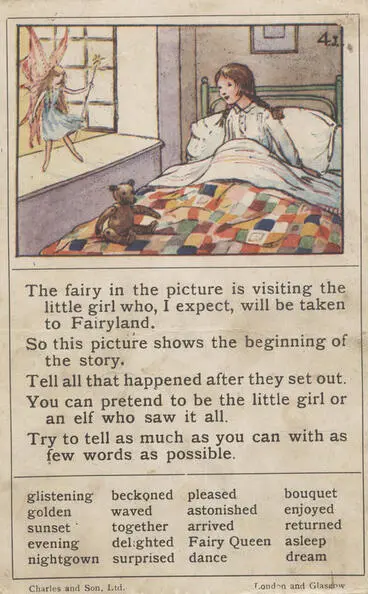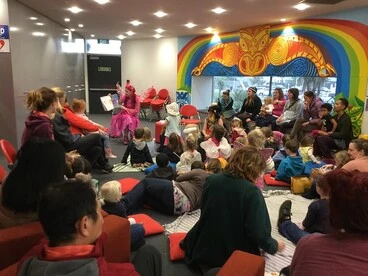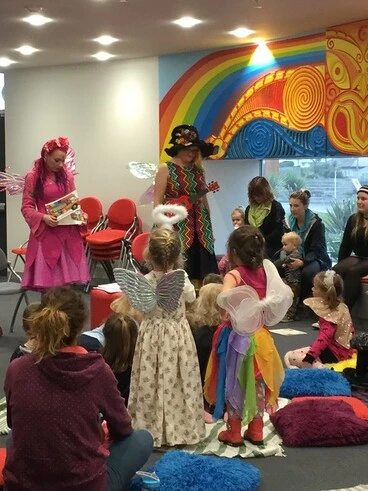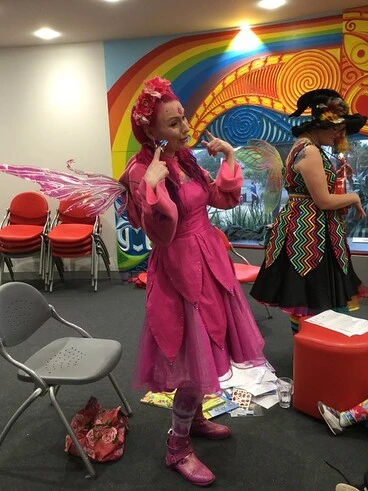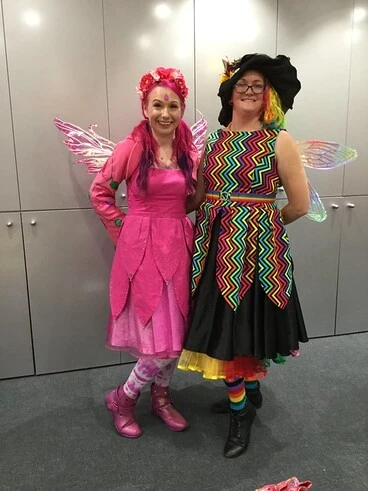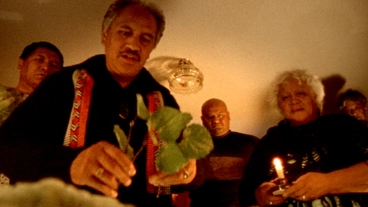Exploring fairy tales
A DigitalNZ Story by Zokoroa
Exploring the wonders of fairy tales of old and contemporary reworkings as fractured and politically correct tales
Fairy tales, Fairytales, Folk tales, Folktales, Tales, Reading, Stories, Māori tales
Once upon a time – enchantment of fairy tales
Fairies, dragons, princesses, giants and other enchanted creatures in far, far away lands have captured the imaginations of children, teens and adults alike.
QUEEN ON THE FAIRIES
Auckland Libraries
Think back to when your family and teachers read fairy tales to you - what are the stories you remember and still treasure!? My teacher read Chicken Licken to our class of five year olds and we were asked to draw a picture about the story. I still remember the colour of the crayon I used and the picture of Chicken Licken scuttling to hide in a cave that I had drawn for her safety (using a bit of creative license!) as the sky was falling.
FAIRY TALES TOLD THE WORLD OVER
Visualise what is happening around the world when it is fairy tale storytime. An interesting article by Kate Lyons (2019) mentions that in India, Tamil fairy tales often begin with “In that only place…”, whereas in Nigeria the Yoruba people begin stories with: “Here is a story! Story it is.” German fairy tales typically end with: “And if they didn’t die, they’re still alive today”, whereas the closing words in Iceland are, “The cat in the vale, lost its tail, end of fairytale”. In this way, fairy tales provide a shared narrative vocabulary between the storyteller and listener, as their thinking is synchronised.
Teacher reading with children
NZEI Te Riu Roa (New Zealand Educational Institute)
Fairy tales of the World website where stories can be read online
Fairy Tales of the world
Services to Schools
ICDL website includes fairy tales, myths and legends written in English and other languages. Also has Māori tales.
The International children's digital library
Services to Schools
Which fairy tales to read?
What are your favourites!? Hans Christian Andersen, Brothers Grimm, Charles Perrault and other authors have inspired imaginations the world over. You can explore online versions of fairy tales at Stories to grow by.
Hans Christian Andersen (1805-1875) - Danish author of "Thumbelina" and other tales
Hans Christian Andersen Fairy Tale Library - Tiny Theatre - Treasure Chest
Museum of New Zealand Te Papa Tongarewa
Brothers Grimm: Jacob (1785-1863 & Wilhelm (1786-1859) - German authors (see gallery of images)
Brothers Grimm
Services to Schools
Charles Perrault (1628-1703) - French author of "Cinderella" and other tales
Jigsaw puzzle - Cinderella image
Museum of New Zealand Te Papa Tongarewa
However, a 2012 UK survey of 2000 parents found that two-thirds were selective about what they read to their children - avoiding scary, awkward and gender stereotypical tales. See list of the top ten fairy tales that were avoided and why in UK Telegraph’s article.
2012 UK survey of 2000 parents: two-thirds avoided scary stories at bedtime
Avoided stories like the tale of two kids - Hansel & Gretel - abandoned in the forest
Radio New Zealand
Parents also avoided tales with awkward questions
For example: explaining a young girl's grandmother had been eaten by a wolf in Little Red Riding Hood
Museum of New Zealand Te Papa Tongarewa
Half of parents said Cinderella didn't send a good message
Reason being that Cinderella showed a young woman doing housework all day
Radio New Zealand
But, in a Radio New Zealand interview (2016), Dr Ellen Handler Spitz explained the psychology of fairy tales - why they're necessary, irresistible, and why being frightened by them is important.
Dr Ellen Handler Spitz (2016) explains why fairy tales, even scary ones, are important
Why scary fairy tales are good for kids
Radio New Zealand
WHY FAIRY TALES ARE IMPORTANT
Fairy tales can provide insights into ideal behaviour, help shape our thinking and way of life, increase our cultural understandings, and stimulate our imagination.
Learning life's lessons:
Fairy tales can provide insights into ideal behaviour and help shape our thinking and way of life. According to Bettelheim, fairy tales give the opportunity to understand one’s inner conflicts experienced during the phases of our spiritual and intellectual development, and to act these out and resolve them in our imagination.
Life's lesson: The three little pigs
Illustrates importance of planning ahead & doing a job the right way (choosing house building materials)
Museum of New Zealand Te Papa Tongarewa
Life's lesson: Chicken Licken
Teaches importance of thinking critically, & separating fact from fiction about the falling sky
Manatū Taonga, the Ministry for Culture and Heritage
Life's lesson: Rapunzel
Demonstrates the importance of problem-solving in letting down her long hair for her rescuer to climb
Museum of New Zealand Te Papa Tongarewa
Stimulating imagination & shaping thinking:
Albert Einstein reportedly said to a mother who had enquired as to what type of reading would best prepare her young son to become a scientist, “If you want your children to be intelligent, read them fairy tales. If you want them to be very intelligent, read them more fairy tales.” He added that creative imagination is the essential element in the intellectual equipment of the true scientist, and that fairy tales are the childhood stimulus to this quality. (Source: Brainpickings)
Sense of wonder:
Fairy tales help create a sense of wonder and curiosity about the world
Museum of New Zealand Te Papa Tongarewa
Window or door:
Provide a window or door into different cultures & ways of doing things
Trove
Learn critical thinking
Learn critical thinking skills by seeing the consequences of characters’ decisions
Museum of New Zealand Te Papa Tongarewa
Mirror:
Provide a mirror that connects to their lives, dreams, anxieties and possible courses of action to solve problems
University of Otago
Emotional resilience:
Build emotional resilience by showing real-life challenges in a fantastical setting with happy and sad endings
Museum of New Zealand Te Papa Tongarewa
Portray values:
Portray values, good and evil, right and wrong, heroes and villains
Museum of New Zealand Te Papa Tongarewa
Increasing cultural understandings, e.g. Māori storytelling:
In her article about how different cultures tell their stories, Kate Lyons (2019) includes the example of Māori storytelling. She cites Te Ahukaramū Charles Royal who explains, “What’s important in Māori storytelling is the constant reconnecting of people with the natural world." Certain formal conventions are followed: “… you start off with a genealogy from earth and sky, and as you come down the genealogy you get to a certain ancestor and when you get to that ancestor you begin the story about that person.”
NZETC: digitised copy of "Fairy folk tales of the Maori" by James Cowan (1925)
Front Cover - Fairy Folk Tales of the Maori
Victoria University of Wellington
Royal gives the following example: “Earth and sky came together and had a child called Tāne, the forest. Tāne then had another child called Mumuwhango and Mumuwhango had another child and that child was said to have been raised upon the ocean … one day the child was on the ocean and met a group of dolphins.” As explained by Royal, the storytelling is as much about those genealogies as it is about the adventures of those individual characters.
Tāne Mahuta
Manatū Taonga, the Ministry for Culture and Heritage
Politically correct fairy tales
Have you seen the book Politically Correct Bedtime Stories: Modern Tales for Our Life and Times written by James Finn Garner in 1994 and revised with additional tales in 2011? Tales, such as 'Little Red Riding Hood', 'The Three Little Pigs' and 'Snow White', were rewritten to provide a moral tale for children. Here’s an extract from 'Little Red Riding Hood': The wolf said, “You know, my dear, it isn’t safe for a little girl to walk through these woods alone.” Red Riding Hood said, “ I find your sexist remark offensive in the extreme but I will ignore it because of your traditional status as an outcast from society, the stress of which has caused you to develop your own, entirely valid, worldview. Now if you’ll excuse me, I must be on my way.”
Tales like Little Red Riding Hood have been rewritten by James Garner in "Politically correct bedtime stories" (1994)
Jigsaw puzzle - Box lid
Museum of New Zealand Te Papa Tongarewa
You'll also find out that Rapunzel’s father is not poor but “economically disadvantaged”, Snow White is not beautiful but “not at all unpleasant to look at”, and the wicked witch isn’t actually wicked at all, but “kindness impaired”. Intrigued? - Schools and home educators can borrow a copy from National Library of New Zealand Services to Schools Auckland and Christchurch centres. Or check your local public library.
Fractured fairy tales
Some fairy tales have been restructured and reimagined to include twists in the telling of the traditional plot - extra characters, new settings, contrary points of view and a different ending. Some examples include:
- Snow White in New York, by Fiona French
- Ninja Red Riding Hood, by Corey Rosen Schwartz
- The true story of the 3 little pigs, by Jon Scieszka
- The three pigs by David Wiesner
- The stinky cheese man and other fairly stupid tales by Jon Scieszka
Stories like Wiesner's "The three pigs" have non-linear plots where story parts can jumble up and multiple stories coexist. Scieska's "The stinky cheese man and other fairly stupid tales" uses intertextual references to and parodying of characters and themes in traditional tales. These types of tales can be used to introduce concepts such as stream of consciousness, intertextuality, and symbolism. The graphics are also a great way to teach visual literacy and how to use context clues to determine the meaning of words. Such retellings of tales can also be used to inspire students to choose a fairy tale and write their fractured version. Tips are given on the ReadWriteThink website.
Animated fairy tales with a twist to the story
Little Red Riding Hood - fixed fairy tales
Services to Schools
Benefits of reading fairy tales aloud
Emotional:
Think of your own reaction when someone reads aloud to you, “Once upon a time . . ." - a feeling of calmness overcomes you as you are carried away into the world of that story’s fantasy! As identified by Bruno Bettelheim (1989) in “The uses of enchantment”, fairy tales have an emotional, symbolic and therapeutic importance. (See article Children need fairy tales (PDF), by Heike vom Orde, 2013)
Fairytales have an emotional, symbolic and therapeutic importance (Bettelheim, 1989)
Children need fairy tales
Services to Schools
Research has shown that not only the language parts of our brain are activated but also other areas such as our sensory and motor cortex as we picture words and their meaning – the story comes alive!
As we picture words and their meaning, the story comes alive!
Dame Flora McLeod telling scottish fairy stories - Photograph taken by Lloyd Cornish
Alexander Turnbull Library
Listening comprehension:
The fantastical world of fairy tales helps children and teens to develop their listening comprehension as they think abstractly and decode the meaning of words. This, in turn, helps them to listen with understanding – predicting, monitoring, connecting to background knowledge and summarising. Listening comprehension is critical to reading comprehension as both require the same strategies to make sense of oral and written language.
Fantastical world of fairy tales helps develop listening comprehension which is critical to reading comprehension
Listening to a fairy tale
Auckland Libraries
Roger Wilson reading the Grimm version of the fairy tale 'Golden Goose'
Golden Goose
Radio New Zealand
Instilling a love of reading:
In addition to providing a mirror and window or door, fairy tales can help children instil a love of reading. Reading stories together helps to build children’s reading skills, which prepares them for academic achievement. As the story unfolds, students can make inferences and predict what will happen next, keeping them engaged. The development of their imagination helps to foster their reading comprehension as they transform words into meaning.
WAYS to Unpack fairy tales:
You can use conversation-starters with children and teens to unpack the message in each tale. As discussed on TKI’s Literacy Online, “Helping students to make connections between what they know and what they are reading improves their comprehension.” There are four kinds of oral language usage and development required by students – independent listening, independent speaking, using social language and applying discussion skills. (See: TKI: Oral language)
Conversation starter:
What did the main character of the story do right? What did s/he do wrong?
NZEI Te Riu Roa (New Zealand Educational Institute)
Conversation starter:
Were there better ways to solve the problem?
NZEI Te Riu Roa (New Zealand Educational Institute)
Conversation starter:
Can you think of similar problems in real life?
Alexander Turnbull Library
ACTIVITIES
There are a range of activities where fairy tales can be explored. For starters, see the lesson plan on TKI: English online - Fairy tales and the various activities on ReadWriteThink, as well as the following ideas accessible on DigitalNZ:
Fairy tale arts, craft and activities
Services to Schools
ReadWriteThink web page on choosing and rewriting a fairy tale
Fractured fairy tales
Services to Schools
Teaching card, Snowwhite
MTG Hawke's Bay
Teaching card, the Tin Soldier
MTG Hawke's Bay
Teaching card, Cinderella
MTG Hawke's Bay
Teaching card, Water lily leaf
MTG Hawke's Bay
Teaching card, Fairyland
MTG Hawke's Bay
Fairy tale play scripts
Services to Schools
A Theatre guide to Little Red Riding Hood
Services to Schools
Make a fairy tale book
Services to Schools
Fairy tales and characters reinterpreted by illustrators
50 Digital fairy tale characters
Services to Schools
Musical Faerie Storytime, New Brighton Library
Christchurch City Libraries
Musical Faerie Storytime, New Brighton Library
Christchurch City Libraries
Musical Faerie Storytime, New Brighton Library
Christchurch City Libraries
Musical Faerie Storytime, New Brighton Library
Christchurch City Libraries
Other Resources
Services to Schools:
- Lending Service: Schools and home educators can borrow fairy tale books
- Topic explorer: Fairy Tales - has links to information about fairy tales, activities, play scripts, animated videos and tales you can read online, including Māori tales.
- Blog post: Children still need fairy tales - fairy tales still need children
Topic explorer: Fairy tales set compiled from DigitalNZ by National Library of NZ Topics
Fairy Tales
DigitalNZ
Digital:
- International Children’s Digital Library has fairy tales written in English and other languages
- MacKenzie College and Community Library — useful list of links to digital resources
- Also check your local public library for access to ebooks and digital resources like TumbleBooks, which is an online collection of stories with animation, music, sound, and narration.
Animated video of "The Three Little Pigs and the Big Bad Wolf"
The Three Little Pigs and the Big Bad Wolf.
Services to Schools
Animated video of "The Deamon, the Woman and the Bird" - African fairy tale from Senegal
The Deamon, the woman and the bird
Services to Schools
Excerpt from TV series Mataku where mysterious putapaiarehe (fairies) appear
Mataku - The Sisters (Ngā Tuāhine)
NZ On Screen
Interview with Illustrator Tokerau Wilson about the fairy tale comic "Cautionary Fables and Fairytales: Oceania Edition"
Cartoons and Folklore in Oceania
Radio New Zealand
Read more:
- The Guardian: Kate Lyon, “Here is a story! Story it is': how fairytales are told in other tongues: (19 April 2019)
- Children need fairy tales (PDF), article by by Heike vom Orde (2013) which summarises key findings in Bruno Bettelheim’s book (1989), ”The uses of enchantment: the meaning and importance of fairy tales”.
- Imagination Soup: Melissa Taylor, “8 reasons why fairy tales are essential to childhood”
- ReadWriteThink: Fractured fairy tales
Anthropologist Dr. Jaime Tehrani of Durham University discusses origin of fairy tales (2016)
The Age of Fairytales
Radio New Zealand
BBC article about the origin of fairy tales (2016)
Fairy tale origins thousands of years old, researchers say
Services to Schools
Interview with Prof Maria Tatar on "Fairy Tales in an Age of Electronic Entertainment" (2011)
Maria Tatar: fairytales
Radio New Zealand
Research on how fairy tales play a substantial role in the shaping of childhoods (2016)
Forever young: Childhoods, fairy tales and philosophy
University of Waikato
Research on fairy tales and gender in Snow White films (2014)
Fairy Tale Femininities: A Discourse Analysis of Snow White Films 1916-2012
Victoria University of Wellington
Kate Camp discusses tales by Hans Christian Andersen, 2008
Kate's Klassic: Hans Christian Andersen's Fairy Tales
Radio New Zealand
